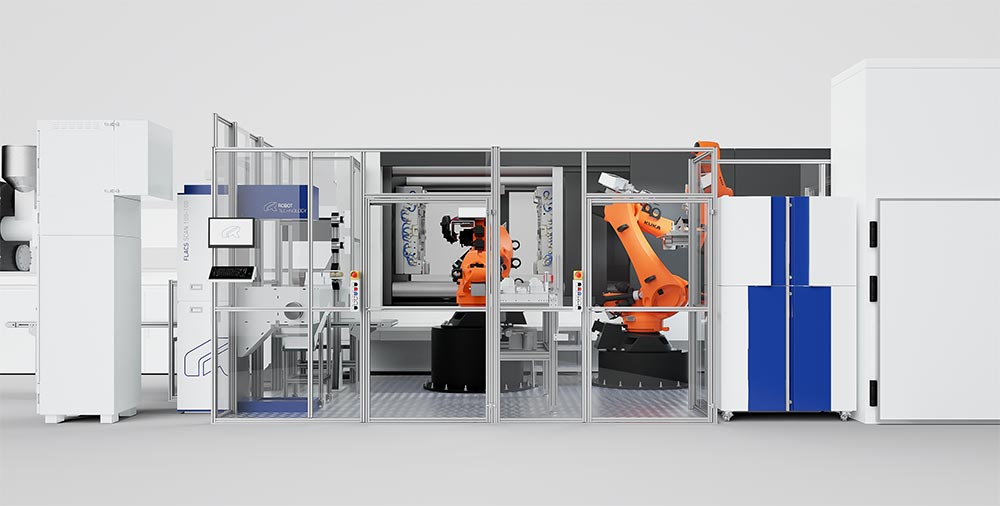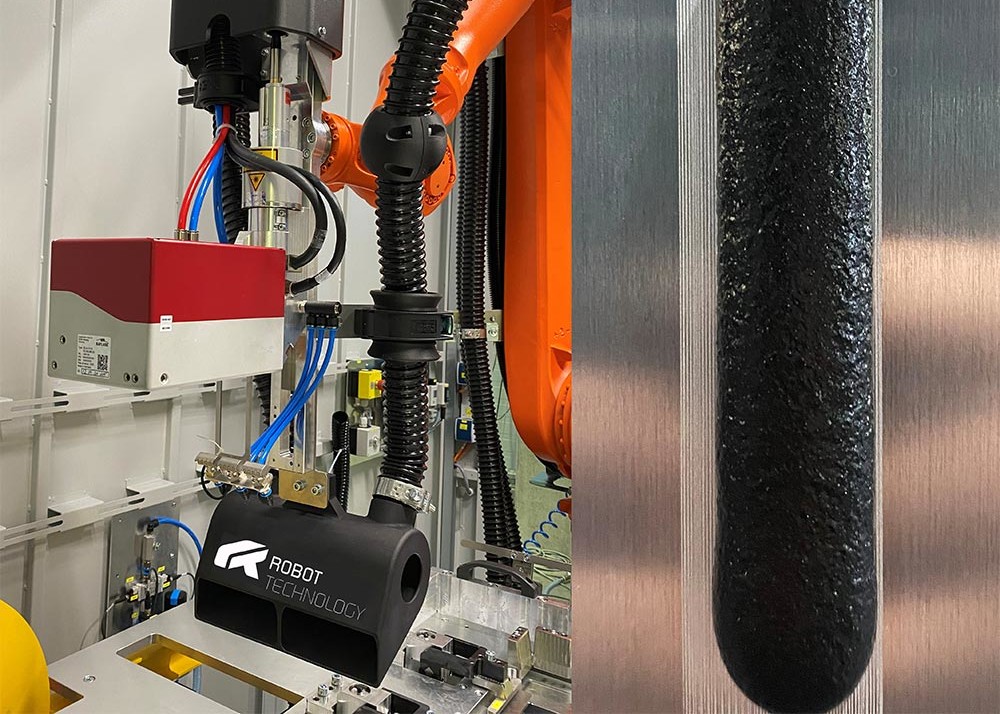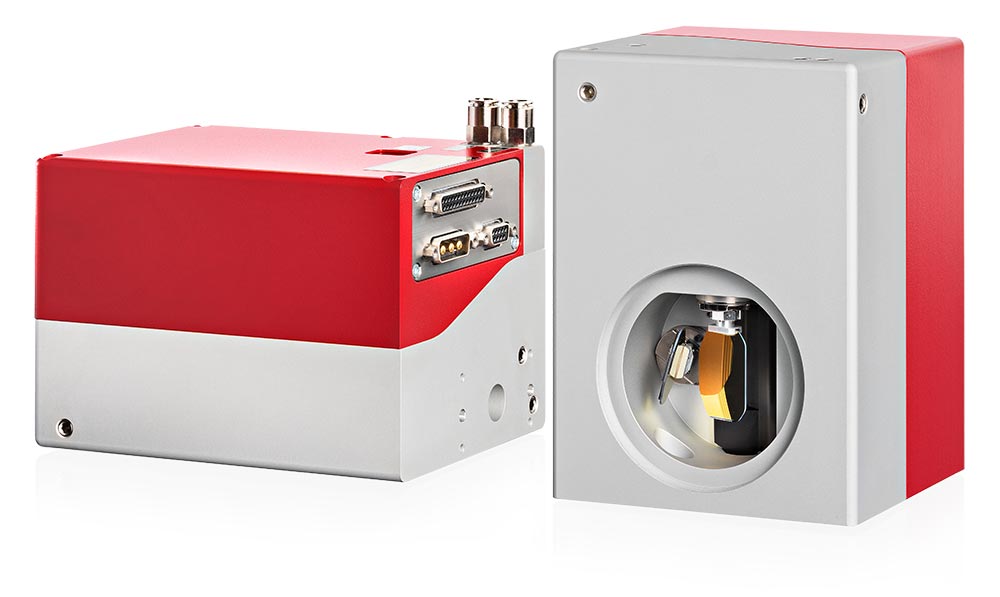pre-Structuring and sealing of battery housings
Scanning system for pre-structuring and sealing of battery housings for battery packs
Which scanning system is suitable for pre-structuring and sealing of battery housings for battery packs?
Laser processes increase efficiency in the area of electromobi-
lity. Of particular significance in this regard are the production stages involved in the manufacturing and construction of batteries in electric cars. These batteries comprise many small and highly sensitive battery cells with a wide range of battery formats. Generally, thousands of these are integrated into the floor panels of electrically powered cars in the form of battery packs. To ensure adequate protection of the battery packs and control electronics, they are firstly encased within aluminium housings in a type of tube section. A special sealing process is required to make the cover fully airtight and waterproof. Innovative laser systems are ideal for completing this task.

ROBOT-TECHNOLOGY supplies laser-based automation systems across the globe, predominantly to the automotive industry. Among other things, the company specialises in fully automated cleaning, structuring and sealing of battery housings. | Source: Robot-Technology
During this process, separating agents and oils often need to be removed without damaging the underlying component. The surface of the aluminium housing cover is then roughened or broken up by the laser for better adhesion of the sealing foam to the surface and to ultimately ensure a permanently sealed connection between components. Next, the 1K foam application is left to harden in the furnace for eight minutes at 80°. The seal itself remains as a solidified film of foam, with a width of 10mm and height of 5mm. It is stable as of this point. The aluminium housing is additionally fastened with approx. 40 screws per housing. This gives the battery packs sufficient protection against water and pressure. It also ensures that the aluminium cover can be removed without causing any damage if the control electronics need to be repaired.
Standard processes for surface preparation using chemicals or abrasive blasting materials make cleaning necessary. The entire component has to be cleaned, even though only certain sections of it have been soiled. Other processes use toxic substances or are less effective than laser systems. All of these drive up the total costs of production.

No masking or demasking is required during laser cleaning, struc-
turing and application of the sealing foam. The close-up shows a foam bead, which is applied to the silver-coloured surface that has
been roughened by laser for improved adhesion. | Source Robot-Technology

During application of the 1K foam, the robot follows the roughe-
ned straight and curved lines created by the laser. | Source Robot-Technology
In contrast, laser deflection units from RAYLASE offer significant benefits. During pre-treatment of battery housings, laser systems enable extreme precision and dynamic responses, without any need for masking. Conventional process steps, such as post-processing and demasking, are eliminated. The laser process is also touch-free and contact-free. The lasers generate the speed required for this application – 16,000mm per second – and thereby achieve significantly reduced cycle times. As a result, the initial investment quickly pays for itself, time is saved and scrap is reduced. RAYLASE has positioned itself as a full-range supplier of a range of deflection units, control electronics and the corresponding laser processing software, also providing end-to-end, sustainable customer service.
THE SUPERSCAN-IV-15- digitally controlled, dynamic, versatile
The laser deflection unit used here for pre-structuring of the aluminium housing cover is the SUPERSCAN IV-15. The laser scanner’s model-based, digital control offers extremely dynamic responses and final speeds, which really come into play when used in ablative processes, such as surface structuring. The robust, water-cooled master block design, in conjunction with quartz-based deflection mirrors, enables applications at up to 3kW with a 15mm mirror aperture or 6kW with a 30mm mirror aperture.

SpeCial Features
- Control via the 20-bit SL2-100 protocol or 16-bit XY2-100 protocol
- Greatly reduced power loss and minimal heat development thanks to a digital PWM output stage
- Highly dynamic responses and high speeds for maximum productivity, in particular for surface structuring processes
- Wide range of mirror substrates and coatings for diverse applications
- Available apertures (mm): 10, 15, 20, 30
SP-ICE-3 Control card
The SUPERSCAN-IV-15 could not exist without a control card. It is an integral part of the scanning system and the essential control unit for all laser processes. Flexibly configurable ports make the SP-ICE-3 control card suitable for universal use, even for very specific applications. Structuring applications can be implemented quickly thanks to the .NET programming environment and the flexibility of the SP-ICE-3 control card.
Your benefits
- Controls 2-, 3-, 4- and 5-axis deflection units as well as all standard laser sources
- Speed- and positioning-dependent laser power control
- Extended marking and processing on-the-fly (MOTF) functionality
- Can also be used as an external control card via Gigabit Ethernet
- Supports RL3-100 protocol

RAYGUIDE LASER PROCESSING SOFTWARE
It is among the most cutting-edge laser processing software on the market today.

Your benefits
- User-friendly graphical interface or SDK programming (software developer kit)
- Embedded GUI and customer plug-ins possible
- Extensive functions for surface structuring
- Management of an unlimited number of control cards
About the Product
RAYLASE – and ROBOT-TECHNOLOGY

RAYLASE products have been used for years by Robot-Technology, a company in Großostheim, Bavaria that specialises in industrial laser applications in the area of cutting, welding and marking. The SUPERSCAN-IV-15 serves to pre-structure the aluminium component so that a robot can then post-process the 1K foam application used for sealing lips. Once the components have been processed, they are placed in a hardening furnace with component-specific conveyor belts. Stefan Maier, Managing Partner of Robot-Technology relies on the successful partnership:
We’ve been using RAYLASE products for over 20 years. They are sophisticated, innovative, and reliable. We found the RAYGUIDE software particularly helpful for our application, as it enables line shifting from straight to curved. (see the picture of the foam application). According to Maier, the current laser-based manufacturing method is now indispensable to battery technology: “Laser deflection units are vital, in particular for the mounting of battery packs in aluminium housing.”
